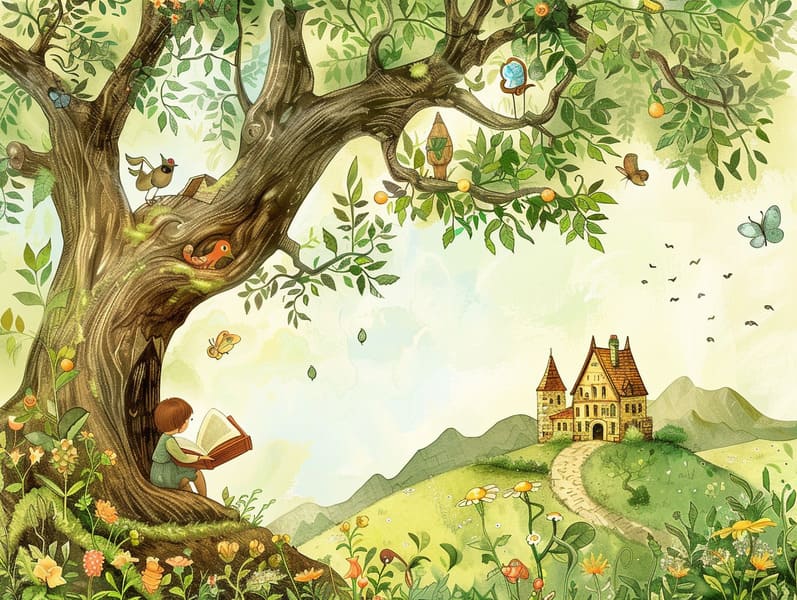
Historical fairy tales have legendary status. These stories have been shared from one generation to the next centuries before they were ever transcribed. They were born from a variety of societies, including Indigenous traditions. They were initially told among adults, often carrying themes and messages mirroring the societal norms and beliefs of the time.
The renowned Brothers Grimm, Jacob and Wilhelm Grimm, were among the first to assemble many of these beloved tales. Their anthology, "Grimm's Children's Stories," included narratives like "Ashenputtel," "Hansel and Gretel," and "Little Snow White," which have since become essentials in the world of traditional fairy tales. Similarly, Hans Christian Andersen's whimsical tales, such as "The Story of the Little Mermaid," and "The Duckling that Could," have gained the love worldwide, ensuring their place in the pantheon of classic fairy tales.
Despite being ancient, fairy tales remain as impactful as ever, especially as children's night stories. These charming stories are now available in numerous formats, including richly illustrated books, fantastical animations, and internet fairy tales.
Their enduring popularity can be connected to several magical reasons:
Ethical Lessons: Timeless fairy tales often offer important moral lessons. Fairy tales like "The Wolf and the Liar" teach the significance of truthfulness, while "The Tale of the Tortoise and the Hare" highlight the qualities of tenacity and modesty. These stories offer children clear distinctions between ethical and unethical, helping to shape their moral compass in a tender yet profound way.
Sympathy and Perception: Ancient fairy tales frequently showcase beings facing trials and tribulations, inspiring readers to resonate with their struggles and back their triumphs. For instance, "Beauty and the Beast" teaches us the benefit of seeing beyond the surface to understand the inner self of a soul, strengthening sympathy and awareness.
Cultural Understanding: Many traditional fairy tales are saturated in the cultural contexts from which they were born. Discovering these fairy tales can provide enlightening views into different beliefs, encouraging a sense of global appreciation and recognition.
Imagination and Creativity: The extraordinary elements in classic fairy tales—mythical entities—stimulate children’s innovative ideas. These narratives guide readers to imaginary realms, boosting imaginative ideas and a sense of astonishment that endures a lifetime.
Classic fairy tales are not only delightful but also illuminating. They serve as fascinating tools in cultivating various cognitive and emotional skills in kids. When timeless fairy tales are spoken out loud, they advance language proficiency by bringing new word meanings and sophisticated sentence structures. This practice also boosts listening abilities and attention, as kids keep up with the story, keen to see what happens next.
Furthermore, conversing about the themes and characters of old fairy tales can nurture intellectual skills and reasoning skills. Young readers are led to see patterns, anticipate outcomes, and make sense of cause and effect. These discussions also help the young articulate their thoughts and feelings, promoting their emotional intelligence.
In today’s digital age, the existence of digital storybooks has made these fairy tales more available than ever. Websites and digital apps share broad selections of popular fairy tales that can be explored or listened via anytime, anywhere. Fairy tales spoken are particularly sought after, extending an fun way these guys for kids to engage with these mesmerizing stories. Sound books and read-to-me videos guide characters and settings to life, often augmented by entrancing soundtracks and tunes that heighten the storytelling experience.
The timeless charm of timeless fairy tales lies in their ability to change to current times while keeping hold of their core messages. Contemporary adaptations of these narratives often introduce more different protagonists and modern settings, making them relatable to today’s audience. However, the basic principles of bravery, kindheartedness, and fair play remain unchanged, continuing to affect readers of all ages.
Old fairy tales also offer a sense of ease and homeliness. They render accessible a well-arranged narrative with a evident beginning, middle, and end, often closing with the wrap-up of conflicts and the triumph of goodness over badness. This foreseeability can be placating for the young, spreading a sense of unwaveringness in an unstable world.
Classic fairy tales continue to bewitch and guide new generations, maintaining their majesty and relevance in modern society. As bedtime stories for kids, they confer a perfect blend of fantasy and learning, enhancing moral values, empathy, and creativity. The availability of free fairy tales online and the likability of fairy tales read out loud affirm that these classic narratives remain reachable to new generations.
By defending and telling these tales, we continue to celebrate the rich tapestry of cultural heritage and cultural heritage. Whether you are viewing a beautifully illustrated book, delving into a online library, or hearing an voice book, the loveliness of Grimm's fairy tales is always within reach. These tales reveal of the continued effect of storytelling and its ability to draw us together across centuries and lands.
Even if you are seeing a vibrantly illustrated book, delving into a electronic collection, or listening on an read-aloud story, the delight of Grimm's fairy tales is always within reach.
These narratives highlight of the lasting strength of storytelling and its ability to bring us together across eras and regions, weaving a spell that charms and informs alike.